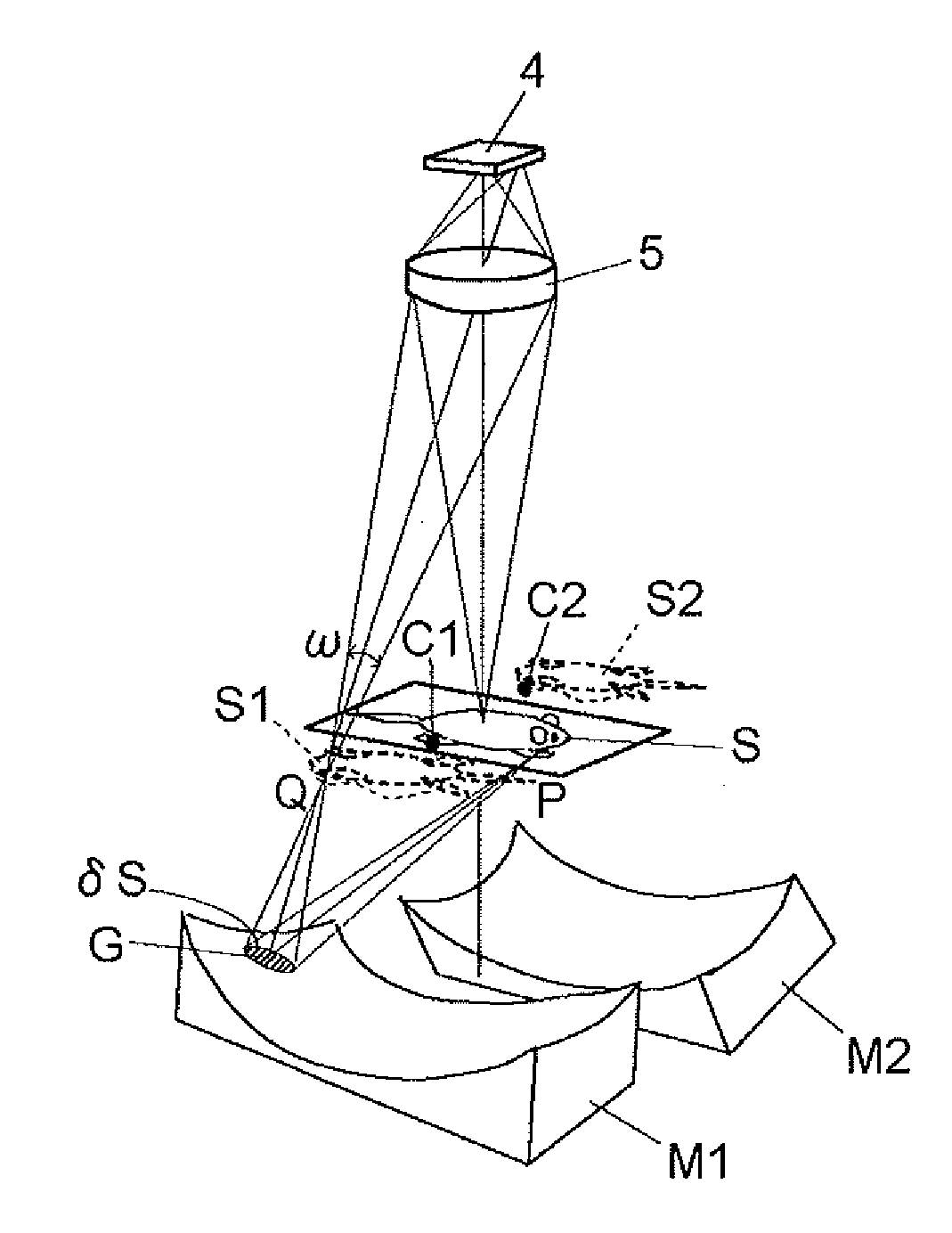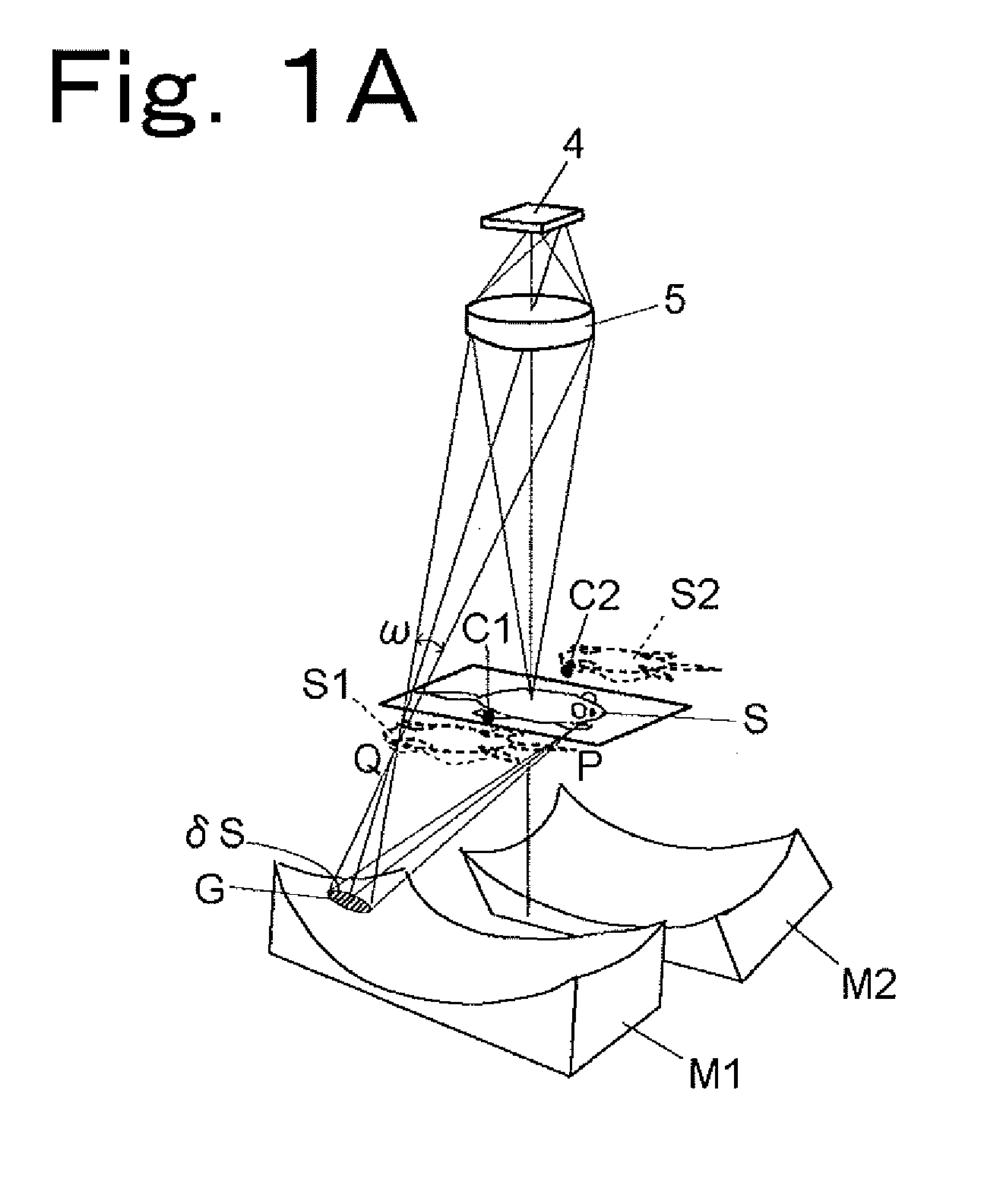Biological Imaging Device
a bioimaging device and optical technology, applied in the direction of optical radiation measurement, spectral modifiers, radiation measurement, etc., can solve the problems of inability to obtain reproducible data, long time period, inability to monitor the growth of cancer cells in the same animal body, etc., and achieve the effect of reducing the astigmatism of a spherical mirror
- Summary
- Abstract
- Description
- Claims
- Application Information
AI Technical Summary
Benefits of technology
Problems solved by technology
Method used
Image
Examples
first embodiment
[0135](Optical System for Simultaneous Observation from Five Directions)
[0136]Hereinbelow, an optical system for simultaneous observation from five directions will be described by way of example with reference to FIGS. 4A and 4B. As shown in FIG. 4A, a sample S is placed in the center of the optical system, and a main imaging lens 5 and a CCD 4 are arranged directly above the sample S (in a direction corresponding to an observation angle of 0°), and four concave mirrors M3, M1, M2, and M4 are arranged in directions corresponding to observation angles of 60°, 135°, 205°, and 300°, respectively. That is, an optical waveguide path in the direction of 0° provides a region occupied by light traveling directly from the sample S to the lens 5, an optical waveguide path in the direction of 60° provides a region occupied by light traveling from the sample S through the concave mirror M3 and a plane mirror M5 to the lens 5, an optical waveguide path in the direction of 135° provides a region ...
second embodiment
[0152]A second embodiment is the same as the first embodiment for five-directional observation except that the two concave mirrors as means for acquiring “images viewed from obliquely above” are changed to plane mirrors. The second embodiment will be described with reference to FIG. 6. As shown in FIG. 6, plane mirrors M5 and M6 are arranged obliquely above the sample S instead of the concave mirrors for acquiring “images viewed from obliquely above” (M3 and M4 shown in FIG. 4A) to form virtual images S3 and S4, respectively. That is, among the five optical waveguide paths, the two optical waveguide paths in the directions in which the sample S is observed from obliquely above are changed to an optical waveguide path in which light travels from the sample S through the plane mirror M5 to the lens 5 and an optical waveguide path in which light travels from the sample S through the plane mirror M6 to the lens 5, but the other three optical waveguide paths in three different directions...
third embodiment
[0157]A third embodiment uses reflection mirrors in combination to measure not the entire body but part of a sample, for example, the head (brain) of a mouse as a sample from four directions (i.e., from above, below, right, and left). The third embodiment will be described with reference to FIGS. 7A to 7C.
[0158]As in the cases of the first and second embodiments, the third embodiment also has the main imaging lens 5 and the CCD 4 arranged above the sample S. However, the third embodiment is different from the first and second embodiments in that the left-side image of the sample S is received by the concave mirror M1 and then reflected by the plane mirror M3 toward the lens 5 and the right-side image of the sample S is also received by the concave mirror M2 and is reflected by the plane mirror M4 toward the lens 5. This technique is a direct reflection of the second principle described above with reference to FIG. 2, and therefore, lateral images S2 and S3 of the sample S are formed...
PUM
| Property | Measurement | Unit |
|---|---|---|
| focal length | aaaaa | aaaaa |
| focal length | aaaaa | aaaaa |
| focal length | aaaaa | aaaaa |
Abstract
Description
Claims
Application Information
 Login to View More
Login to View More - R&D
- Intellectual Property
- Life Sciences
- Materials
- Tech Scout
- Unparalleled Data Quality
- Higher Quality Content
- 60% Fewer Hallucinations
Browse by: Latest US Patents, China's latest patents, Technical Efficacy Thesaurus, Application Domain, Technology Topic, Popular Technical Reports.
© 2025 PatSnap. All rights reserved.Legal|Privacy policy|Modern Slavery Act Transparency Statement|Sitemap|About US| Contact US: help@patsnap.com



